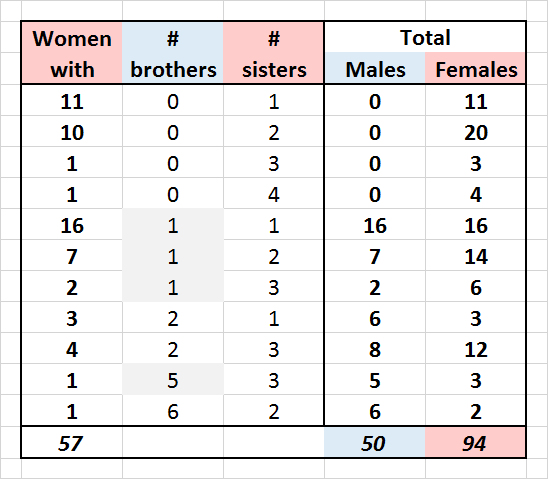
Ascertainment Bias in a determination of the Primary Sex Ratio:
a classroom demonstration
The Primary
Sex Ratio is the ratio of males to females
in a population: it is expected to be 1:1. One
possible way to count this is to ask a group of people how
many brothers and sisters are in their families (including
themselves). For example, n = 57 women in Biol2250
were asked to give the counts for their families, with the
results as reported above. The ratio of male : female
is heavily skewed towards women, almost 2:1 [to be
precise, 1.88:1] instead of the expected 1:1.
Why? A census limited to women is guaranteed to include a large number of women (n = 11 out of 57 respondents) that are "only children" (one girl, no boys), and also a number of women from larger all-girl families (a further 12 respondents). Such a census also excludes the reciprocal family types, those with single or all-boy makeup. The result is an ascertainment bias, a mismeasurement of a phenomenon by an error in which the measurement is made. One correction is to exclude all respondents with no brothers [first four lines], which in these data would give a male : female ratio of 50:56. A bias in the other direction is expected from a census limited to men. Another correction is to exclude the sister reporting the count (the proband), which means subtracting one sister from each line and redoing the math: the calculation is left as an exercise for the student.
Homework: Suppose the classroom measurement of the primary sex ratio were done for all undergraduates in the Department of Biology, irrespective of gender. Would you expect a 1:1 ratio? Why or why not? Hint: suppose you made this count at the Royal Military College.
Why? A census limited to women is guaranteed to include a large number of women (n = 11 out of 57 respondents) that are "only children" (one girl, no boys), and also a number of women from larger all-girl families (a further 12 respondents). Such a census also excludes the reciprocal family types, those with single or all-boy makeup. The result is an ascertainment bias, a mismeasurement of a phenomenon by an error in which the measurement is made. One correction is to exclude all respondents with no brothers [first four lines], which in these data would give a male : female ratio of 50:56. A bias in the other direction is expected from a census limited to men. Another correction is to exclude the sister reporting the count (the proband), which means subtracting one sister from each line and redoing the math: the calculation is left as an exercise for the student.
Homework: Suppose the classroom measurement of the primary sex ratio were done for all undergraduates in the Department of Biology, irrespective of gender. Would you expect a 1:1 ratio? Why or why not? Hint: suppose you made this count at the Royal Military College.
Table
& text material ©2024 by Steven
M. Carr